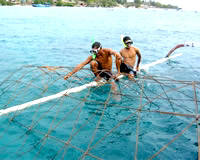|
| |
Innovative Program to Resurrect Dying Coral Reefs
Launched in Lombok
The Reef Electric - Bio Rock

(1/3/2005)
A set of bright pink marker buoys off the Gili Islands in Northwest Lombok marks
the location of a dynamic and innovative program that promises new life to
world's threatened coral reefs.

Co-conceived by coral expert Tom Goreau and architect Wolf Hilbertz, Bio Rock,
or Electric Reef installations, have proven successful in creating new coral
reef habitat, not only in Indonesia, but in numerous locations around the
region.
At the invitation of long-time Bali resident Cody Schwaiko, and Bali Hai
Diving Adventures - Tom Goreau and Wolf Hilbertz recently visited Gili
Trawangan to assess the area's suitability for a trial installation. After
receiving the initial "thumbs up" and funding from the Vila Ombak Diving
Academy together with other local community support, the Gili's first Bio
Rock installation was "plugged in" on November 20, 2004.
Coral Arks and Bio Rocks
Known in some circles as "Coral Arks" because of their proven ability to
create new havens for fish and corals in areas where human impact has damaged
coral reef habitat, the new artificial reef on Gili Trawangan was constructed
using steel bars and copper wiring to produce a tunnel-like steel foundation.
Electrodes are attached to transmit low-voltage electrical current into the
seawater surrounding the steel structure. Driven by an onshore power source or
solar panel, the voltage employed is equivalent to that of a 60-100 watt light
bulb.
How Does it Work?
In combination with an anode and cathode, the electric current causes dissolved
minerals in sea water to crystallize, forming a limestone coating over the
exposed steel, a perfect media for coral larvae - the basic building block of
the reef. To further accelerate reef establishment and in a process know as
"seeding," the Vila Ombak Diving Academy Team collected live coral
fragments already detached from surrounding healthy reefs, and physically
attached them to the structure.
The results of this innovative approach to creating new coral reefs has been,
both literally and figuratively, electrifying. Studies show resulting
reef growth rates that are three to five times that of un-stimulated coral.
Other studies indicate stimulated coral may also be more tolerant to changes in
surrounding water temperature.
Local Community Support Essential
Local community support is considered essential to the success of any
environmental initiative. The Gili Island Bio Rock Project draws much of
its inspiration from the village head on Gil Trawangan, Taufik, who is an avid
SCUBA diver. Taufik's commitment to project, his socialization of the project to
his local constituents and the services of a local marine patrol funded by the
Gili Eco Trust are all playing key roles in the ongoing success of the
project.
On November 23, 2004, the Vila Ombak Diving Team lowered the first
completed structure carefully into place. Taufik, in his capacity as village
leader, was given the honor of becoming the first diver to seed the structure
with a coral fragment.
Within just 16 hours of the introduction of electricity there was a visible
white film already forming on the exposed steel. Resembling an underwater
Christmas tree adorned with carefully attached coral decorations, Moorish
idols and Damsel Fish were already winding their way in and out of
the structure. A fantastic green and yellow miamiridae nudibranch had
also moved in, declaring the structure its new home.
As a finishing touch, Taufik painted the succinct message on the surface marker
buoys saying "Keep and Protect this Place" and the installation was complete.
If you'd like to learn more about the Vila Ombak Diving Academy's Coral
Reef Education Program or about the Bio Rock project, Contact:
© Bali Discovery Tours.
Articles may be quoted and reproduced if attributed to http://www.balidiscovery.com.
All images and graphics are copyright protected.
http://news.giliislands.com/2004/12/new-coral-reef-habitat.html
| |
|
